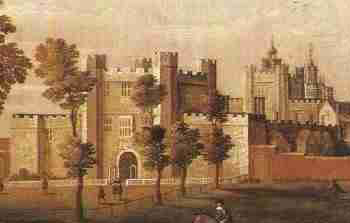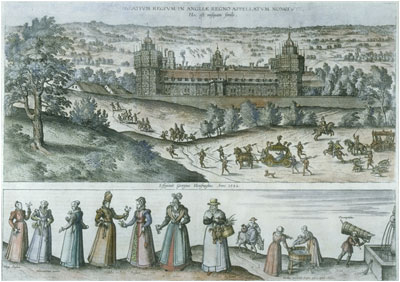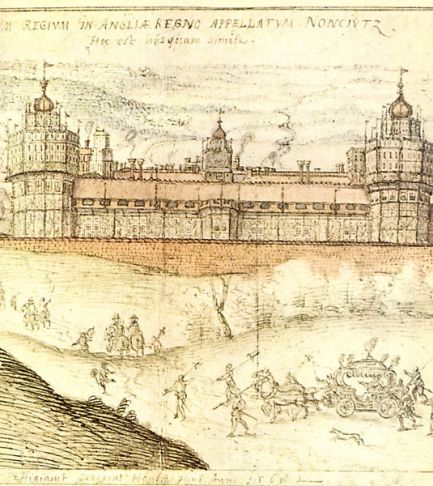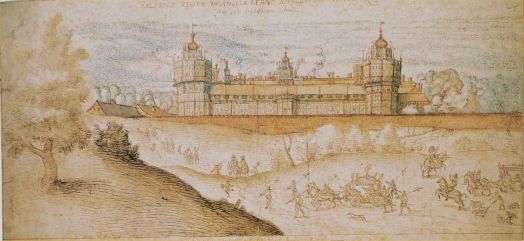Nonsuch Palace
Jump to navigation
Jump to search
VIDEOS
| NONSUCH PALACE 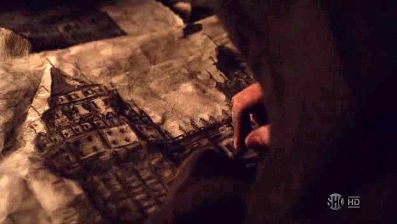 the only thing that now indicates the position of this Royal Palace are undulations in the ground and 3 concrete pillars. 6 miles north-west of Hampton Court Palace Want to add to this page? Click EasyEdit to update this page! (Don't see the EasyEdit button above? <a href="../#signin" target="_self">Sign in</a> or <a href="../accountnew" target="_self">Sign up</a> |
News Release from Christies Auctioneers: RELEASE: THE MOST IMPORTANT DEPICTION OF HENRY VIII’S ‘LOST’ PALACE TO BE OFFERED AT CHRISTIE’S IN DECEMBER 2010 The earliest and most detailed depiction of Nonsuch Palace – Britain’s most ambitious Renaissance commission – unseen in public for nearly 25 yearsLondon – Christie’s announce that they will offer an exceptionally rare and beautiful depiction of the ‘lost’ palace of Nonsuch at the auction of Old Masters and 19th Century Art on 7 December 2010. Commissioned by King Henry VIII in order to outshine the great palaces built by his rival King François I of France, the building of Nonsuch Palace began in 1538 and took 8 years to complete. It stood for less than 150 years having fallen into disrepair in the 1680s. The earliest and most important contemporary depiction of Britain’s most ambitious Renaissance commission, the present drawing is an extremely valuable record of the ‘lost’ palace and has been seen in public only twice before; at Sutton Place in 1983 and at The National Gallery, Washington, in 1986. Described by Martin Biddle as ‘the only surviving impression of what Nonsuch really looked like’, it is expected to realise £800,000 to £1,200,000.UPDATE - December : The painting of Nonsuch Palace mentioned here failed to reach the reserve price, so it was not sold. 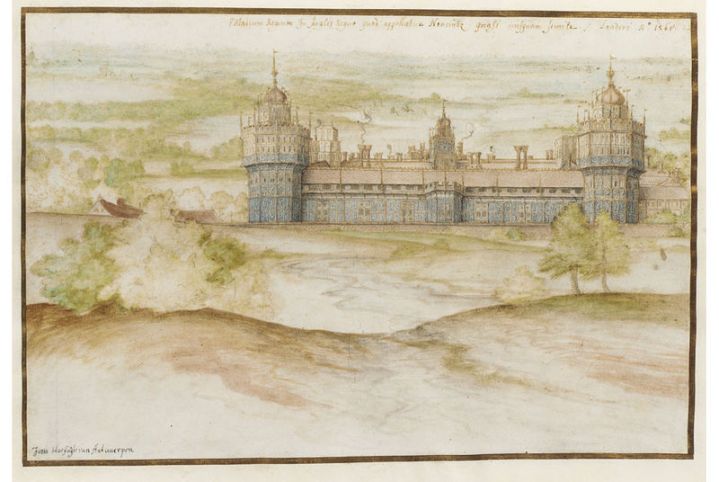 Benjamin Peronnet, Director and International Head of Old Master and 19th Century Drawings, Christie’s: “This is an exceptionally rare and exciting picture; not only is it one of the earliest British watercolours and a work of art of immense beauty, but it is also the most exact pictorial record of Henry VIII’s great commission, Nonsuch Palace. Henry’s determination to build the grandest of palaces was fuelled by his rivalry with François I of France who was a great Renaissance patron of the arts and who built the palaces at Fontainebleu and Chambord. Nonsuch Palace stood for less than 150 years and there are only four contemporary depictions that are known to survive. Of these the watercolour to be offered at Christie’s is the earliest, and the only one to show a true impression of the ‘lost’ palace.” The watercolour was executed by Joris Hoefnagel who provided the illustrations for Civitates Orbis Terrarum – an extremely important record of all most important buildings and cityscapes in Europe first published in 1572. Almost all of the 546 drawings made for this book are in public collections, with the majority, more than 60, in the National Library in Vienna. Hoefnagel executed the present work in situ at Nonsuch and used it to create a later, less detailed depiction that was used for the engraving. This later version is now in the British Museum. The present work was acquired in the mid-19th century by Sir Alfred Morrison of Fonthill – one of the most celebrated British collectors of the 19th century - and has since passed by descent. After Hoefnagel’s two depictions of the Palace in the 16th century, no other representations are known until John Speed’s exaggerated thumbnail engraving of 1610. The only other known depictions of the Palace are those in the Fitzwilliam Museum by an unknown artist (1620) and a view by Hendrick Danckerts at Berkeley Castle (circa 1660). Nonsuch Palace is also extremely important as one of the very earliest surviving watercolours executed in England. Contemporaneous with the watercolours of Jan Brueghel, the drawing pre-dates by 60 years the comparable landscapes of Anthony Van Dyck – often considered the inventor of the English landscape watercolour. |
(large pics on left and small pics & text on the right.)
| The builders of Nonsuch recycled materials from the medieval monasteries that had recently been suppressed. When the palace was completed, around 1540, it was named Nonsuch, as it was considered to be like no other palace in England. "There was nonsuch like it." Nonsuch Palace was a dazzling fortified brick and stone hunting lodge. In April 1538, this early Renaissance palace completely swept away, the village of Cuddington with its church and manor house. Still unfinished by 1556,Henry Fitzalan, 12th earl of Arundel, completed the multi-storied palace, of two wards, fortified by turreted gatehouses. From the north, guests would enter the outer court and then through the smaller inner gatehouse, by a flight of eight steps. In the inner court, the panels of the first floor walls, were emblazoned by life-size stucco figures of gods and goddesses, moulded in high relief. | |
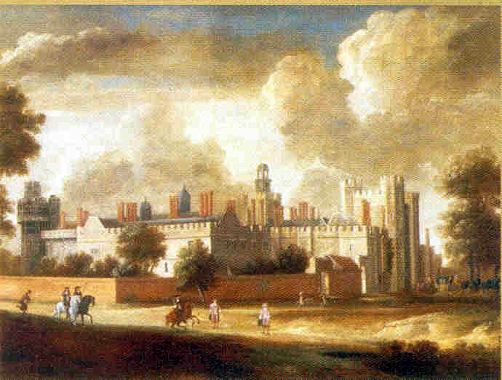 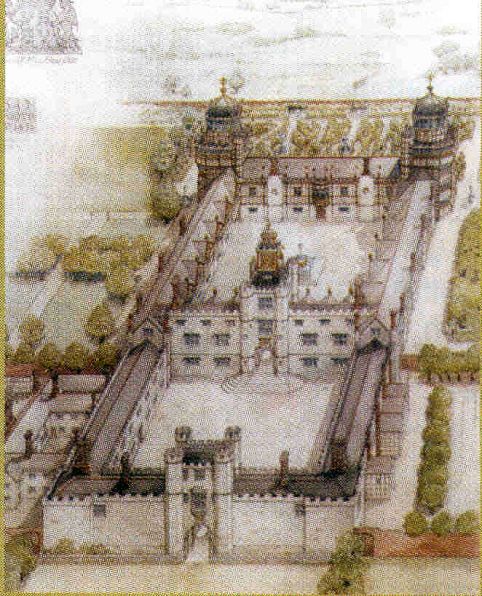 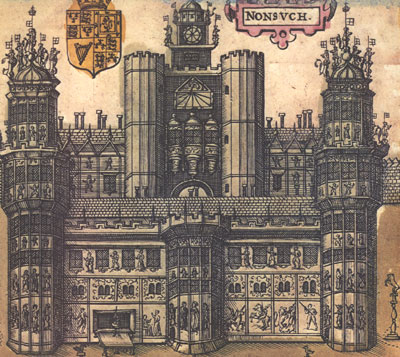 c. 1610 John Speed, from his map of Surrey, 1610. It shows the classical designs on the slate outside. There were also stucco designs on the inside court which are well documented from the late 16th century by foreign visitors. The designs are of Julius Caesar, various Caesars, the Virtues and the Labours of Hercules. 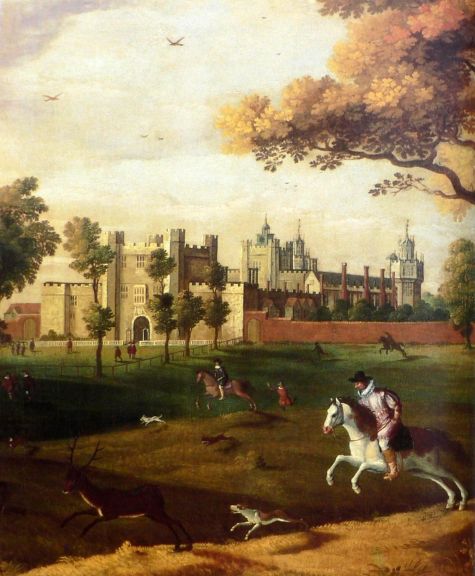 c.1620 | In 1538 Henry VIII owned 13 palaces in and around London. Unlike most of these, Nonsuch was built from scratch to satisfy the King's desire for a splendid hunting lodge in his great new hunting estate close to London and to his riverside palace at Hampton Court. The location chosen was Cuddington, near Epsom in Surrey, which was razed by an army of workmen who descended on the site on 22 April 1538, the 30th anniversary of Henry's accession. When he died on 27 January 1547, the palace was still unfinished, but what little remained to be done was completed after 1556 by Henry Fitzalan, 12th Earl of Arundel, who had part-purchased, part-swapped the palace and Little Park with Queen Mary I, who disliked hunting and had considered demolition, in exchange for Norfolk estates. Elizabeth I stayed frequently at Nonsuch, firstly on her Summer progress of 1559. After Arundel's death in 1580 his son-in-law, John, Lord Lumley, inherited the palace, creating a splendid library of books and the first truly Italianate garden planted in England. Nonsuch returned to the crown in the last decade of Elizabeth's reign and was maintained as a royal palace until the Civil War. Along with all other royal properties, Nonsuch was confiscated by Parliamentary commissioners and sold off after the execution of Charles I in 1649. The 1650 survey of the house and its grounds, which survives in the Public Record Office, forms a unique record of the magnificence of the complex. The final stage in the chequered history of Nonsuch followed its return to royal hands in 1660, when in 1670 Charles II gave the palace to his then mistress, Barbara Castlemaine. In 1682 the extravagant countess decided to embark on its demolition to save its upkeep and to realise the value of its building materials, and possibly also to express her dislike of the keeper of the palace, George, Lord Berkeley, who had previously and illegally demolished the Banqueting House for its hardcore value. The demolition process must have gone on for some time, for part of at least one of the gate houses was still standing in 1702. [source: <a class="external" href="http://www.britarch.ac.uk/ba/ba60/feat1.shtml" rel="nofollow" target="_blank" title="British Archeology Magazine August 2001">British Archeology Magazine August 2001</a>] |
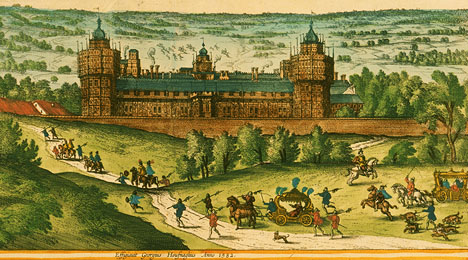 Georg Hoefnagel (1542-1600) Palatium regium in Angliae regno appellatum Nonciutz. 1582. Engraved by Franz Hogenberg, c1598 Elizabeth's court traveled with her when she went around the country on her progresses. This colored engraving shows her arriving at Nonsuch in a plumed coach, as she must have done on many of her visits. The palace was built by her father, Henry VIII. In August 1559, during her first summer as queen, the earl of Arundel entertained Elizabeth at Nonsuch. He arranged for magnificent banquets, as well as a masque, music of drums and flutes, and other festivities that kept the party going until 3AM. | Queen Elizabeth I loved <a class="external" href="http://www.gardenvisit.com/garden/nonsuch_palace" name="Nonsuch" rel="nofollow" target="_blank">Nonsuch</a> particularly, though there may have been some slight regret when she remembered that it had once been a royal seat; but still in her usual way she allowed the earl to complete the building, and only bought it back after he was dead. Then it was her favourite till the last years of her reign. Hunting was at its very best in the park at Nonsuch, which was well stocked with wild animals, She loved to have hunting-parties on festive occasions, and even in her sixty-seventh year she was to be seen every day at the chase. It was at Nonsuch that she died. |
VIDEOS
<embed allowfullscreen="true" height="282" src="http://wikifoundrytools.com/wiki/thetudorswiki/widget/youtubevideo/7d67b7ea8d131a9d845e623a101504f5808b5d17" type="application/x-shockwave-flash" width="344" wmode="transparent"/> | <embed allowfullscreen="true" height="283" src="http://wikifoundrytools.com/wiki/thetudorswiki/widget/youtubevideo/4276a29b99b2d0785cc97a2c0d7c8c3ba0b90829" type="application/x-shockwave-flash" width="344" wmode="transparent"/> |
LINKS:
| LITERATURE:
|

